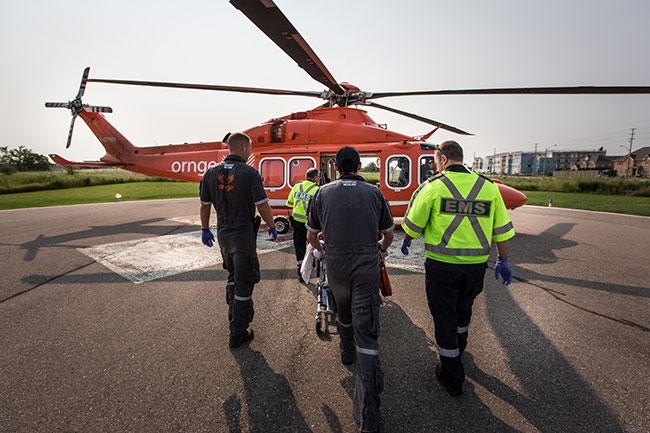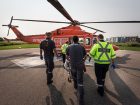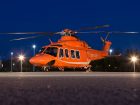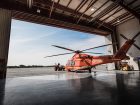
Features
Safety & Training
Standards & Regulations
Steady on to Safety
January 2, 2018 By Matt Nicholls
The second annual All Canada Aeromedical Transport Safety conference took place Nov. 21 to 23 at the Ornge headquarters in Mississauga, Ont. The event entertained 56 attendees from 21 organizations – a nice uptick from the 37 attendees last year.
 Ornge is looking to get out ahead of fatigue regulations. The second annual All Canada Aeromedical Transport Safety conference took place Nov. 21 to 23 at the Ornge headquarters in Mississauga
Ornge is looking to get out ahead of fatigue regulations. The second annual All Canada Aeromedical Transport Safety conference took place Nov. 21 to 23 at the Ornge headquarters in MississaugaMore than 40 medical professionals from various backgrounds were on hand to share solutions to common safety issues and discuss potential solutions.
Sponsored by Leonardo Helicopters and global insurance firm Willis Towers Watson, the event explored topics including the development of Ornge’s new Aeromedical Resource Management (known as AMRM) Standards program; fatigue management realities and their affects on pilot and crew performance; disaster recovery strategies; and more.
Ornge COO Rob Giguere said the conference enabled attendees to share best practices in a Canadian environment, which is different from the United States. Helicopters’ had a chance to sit down with Giguere and talk about the one-of-a-kind event.
Q. Rob, I had the opportunity to sit in on some of the second annual ACAT Safety conference today. Impressive. What are your thoughts on the importance of this event for the air medical community and how has it grown in its second year?
A. David Huntzinger [Ornge’s Director of Aviation Safety] is very well known in the U.S. and has had some very significant safety roles in various organizations besides his extensive background with Navy training and EMS. Dave came to me with the idea of a conference. We are members of HAI [Helicopter Association International], we go to the AMTC [Air Medical Transport Conference]. We have been sharing discussions with other operators in the U.S., and these events are always U.S.-focused. We talked to some of the Canadian operators – B.C. Ambulance, STARs, etc. – and the consequence was, we should get together. So I said to Dave, “away we go.”
We’ve got a great safety team which put the conference together. We didn’t do much advertising and people started hearing about it and came to us at the end of last year’s event to see if they could come and join us. We had a diverse, larger audience this year.
The information itself that we provided was very well received. But there are other important reasons for the conference. The sharing of best practices and safety initiatives…you learn an awful lot in your environment. The Canadian market has different challenges than the U.S. and we operate in different environments across the country.
Another reason is this gives us a common voice, a common platform for the group. If the group decides something needs to be done, we can speak with a common voice. The focus is moving patients safely in aircraft, very simply put. How do we do it better in favour of the patients we serve?
Q. What did you learn at the conference?
I learned we need a bigger room! [laughs] Certainly everyone learned a great deal. The session on fatigue was interesting. It has become very topical. When you were flying as a young guy – I used to fly with Second World War captains – they managed their fatigue in different ways. There was no book on fatigue, but the world has changed. Ornge is moving into fatigue risk-management early – as a 703, 704 operator we don’t have to for some time yet – but we are moving into it early to be leaders and looking at how we can mitigate the effects of back-of-the-clock flying and long shifts, as we do both.
Q. Ornge was recently cleared of negligence by an Ontario Supreme Court judge in the 2013 Moosonee crash. Can you comment on the ruling and what it means to Ornge team?
We are very mindful that we lost four of our colleagues in that accident. It was very tragic and it took its toll on the organization and everyone here. It is still remembered as a remarkably sad day here, obviously. We have been in this process for some time and we’re respectful of the court process and the outcome. Losing four of our people – you can never forget it. We have changed one of our conference rooms here to Moosonee as a constant reminder. There is a plaque inside with the names of the two pilots and two paramedics who we lost in that accident. It’s always in our mind.
Q. How has the accident helped as a catalyst to change?
It may not be directly related but you are always conscious of it. My focus for my entire career has been, “How do we do things safely?” and “How do we do so efficiently?” and not much has changed in the way in which we approach these principles. It’s top-of-mind and we are on a steady path to innovate.
For example, several years ago we put solar lights at all of the unlit helipads with cones across the province. On one of my first base visits when I joined Ornge, one of our younger pilots explored the pad they go to in the Kenora region. He explained the AvLight solar lights. We started to add them in the region and had good results, so we rolled them out across the province.
Q. Can you expand on the safety enhancements you have made in the past three years to enhance the safety culture at Ornge? What are the most important enhancements?
The TSB report into the Moosonee accident was a long one, but in that report there were no recommendations for Ornge because we were pushing hard to upgrade operations. When I look back at the number of things that were initiated over the past number of years…we did the solar lights and because of the black holes common in our operation, we sent one of team members on the TERPs [Terminal Instrument Procedures] course and started building VFR approach plates for blackhole pads.
We re-introduced underwater egress training. It’s now done every year. We conduct the training around the province every year, which is very good. AMRM has been huge for us. It brings the team together, it allows each team member in the various areas of responsibility to talk about focus and what we should be doing everyday, so this aspect has been really strengthened over the last number of years.
We use the FRAT – Flight Risk Assessment Tool –in fixed wing and rotor wing operations. The pilots complete that before their shift depending on the mission. FDM [Flight Data Monitoring] in the AW139 – not all of the aircraft have been modified, but we are starting this in all of the aircraft now. This year, we will do so in the PC-12, which is kind of a first for EMS operators.
ACAT is an industry event, but it gives everyone in the building some renewed focus. We need people to understand that although we are aviators who move patients every day, there is a safety component in every single thing we do.
When you have a good idea, you try it and you find out if it is a good idea. For example, we introduced something called a “QT” or QuickTurn. When something interesting happens – something safety-related that everyone can learn from – within 24 hours we put out a company-wide bulletin via email providing factual details – literally, a ‘quick’ turn!
It was amazing how this fixed wing, rotary wing and maintenance tool caught the eye of the paramedics. They said, “What about the things that go on in paramedicine?” Then on the operational side, our control centre and dispatchers said “Shouldn’t we have this too?” Now we have QuickTurns across the company. And they are a discussion point for AMRM everyday as well.
An advantage of a QT is that everyone gets the same information on the same issue. It informs and quells rumours by getting out accurate information. Recently we have introduced a “QT2” which is the follow-up. This provides further information about what has happened and how we addressed it. Also, these are carried in Ornge’s “Aviation 360”, our monthly publication on safety. Quick Turns are discussed at morning and evening AMRMs. It’s more information for people to understand. For example, it could be going into an airport they changed an approach on. It’s just one more piece of information they can use.
Q. Ornge was up for the Airbus Innovation in Safety Award this year, and though it didn’t win, it is a testament to the steps you have taken to redefine processes there. Can you comment on how you feel Ornge is innovating in the safety realm?
We are looking at everything that we can do to move the bar up. I take the long view on things – let’s solve the immediate problems and then look at the long term. Do we have to put FDM on our fixed and rotary wing aircraft? No we do not. There is no regulation or requirement. It’s expensive, but if we want a best practice, we need to analyze what we are doing out there.
Q. What other strategic changes would like to implement at Ornge to help enhance aviation safety? What are your greatest challenges and possible solutions?
We would like to change to strengthen the organization. In the North, we are sometimes the only service in town. First Nations communities in the North and South, some are better supported than others in terms of aviation infrastructure, which is not always ideal. But improving the infrastructure in the North at the airports would be a goal.
There are great opportunities to improve our organization and operation, and other opportunities in terms of approved approaches, lighting and de-icing. You are always looking at improving the system.
ACAT Conference
The second annual All Canada Aeromedical Transport conference (ACAT) took place in Mississauga, Ont. Nov. 21-23 and this year’s event built on the strong safety foundation set by last year’s inaugural gathering. Hosted by Ornge, Ontario’s provider of air medical transport services, the conference brought together more than 50 air medical transport professionals from across Canada for educational enhancement and training opportunities in a variety of areas unique to the aeromedical transportation environment, including night vision goggle usage in a scene flight environment, including AMRM, fatigue management, SMS, human factors, just culture, communication, emerging technologies, drones and more.
The purpose of the event was to discuss safety practices, industry trends and develop a framework to enhance and share best practices. The conference attracted delegates from more than eight fixed- and rotary-wing medical transport operators from across Canada. Event participants heard from Kenyon International Emergency Service provider CEO Robert A. Jensen, one of the key speakers at the event.
“The aeromedical community operates in some of the harshest flying conditions, providing valuable lifesaving treatment and transport. Because of the conditions they operate in, they are also one of the most safety-focused groups in aviation,” Jensen said. “I am very pleased to support Ornge and the many operators who take part in this conference by sharing experience and lessons learned about how to manage the very rare times when things don’t work. Sharing lessons learned is not only valuable for prevention but also in managing responses so that the people and families directly affected in incidents are taken care of.”
A not-for-profit organization, Ornge co-ordinates all aspects of Ontario’s medical system, the critical care land transport program, paediatric transport program and the authorization or air and land ambulance between hospitals. Ornge performs some 18,000 patient related transports in Ontario each year.


